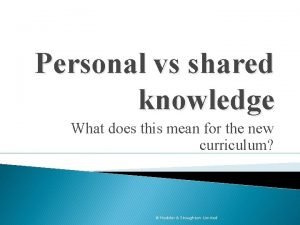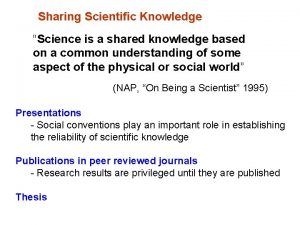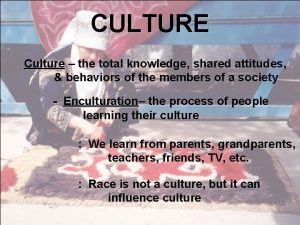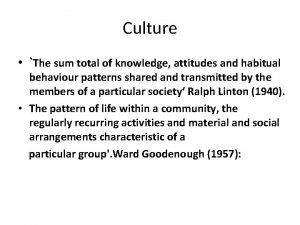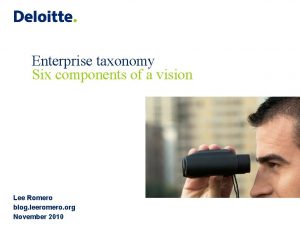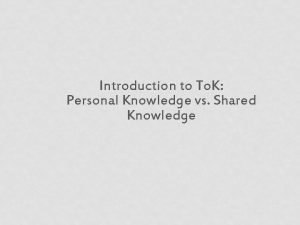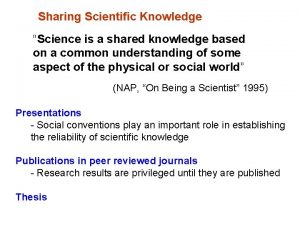Personal vs shared knowledge What does this mean























- Slides: 23

Personal vs shared knowledge What does this mean for the new curriculum? © Hodder & Stoughton Limited

A new diagram Personal knowledge Shared Knowers knowledge ‘I know because …’ ‘We know because …’ © Hodder & Stoughton Limited

Considering the same knower on different parameters The same person listens to a lot of classical music, but also does a little bit of composing for classical guitar. Shared knowledge Someone who was born in 1995 and knows about the ‘We know of assassination because …’King, Martin Luther Jr. only from history books The same person is the. Personal only one who knows how he feels knowledge when he stands in ‘I know the Sistine Chapel because …’ and looks at the ceiling. Shared knowledge as SOURCE of personal knowledge © Hodder & Stoughton Limited

Comparing different knowers • Someone who has heard of Pablo Picasso, but who has never seen any of his artwork, and who doesn’t read about it or go to art museums A professional historian who has not only studied the history of Russia for many years, but who has also contributed much to ‘Weshared knowledge through research, because …’ and publications Personal professional knowledge presentations Shared knowledge ‘I know because …’ Illustrating how much of the available shared knowledge an individual has learnt • Someone who has studied the moon landing in school, but who has done no further reading or research • Someone with a passion for American football, goes to 49 er games, reads Sports Illustrated and participates in trivia contests © Hodder & Stoughton Limited

Comparing different knowers (continued) Person 3 A member of the Olympic gold-medal winning curling team who has been curling for 32 years Person 1 Shared knowledge Someone who has heard of curling, but has never seen it played Person 4 An amateur curler who plays on a local team a few weekends a year, but who also watches curling on television whenever possible and has read some books about the game ‘We know because …’ Person 2 A curling fan, who watches curling on television and reads an online curling blog but who lives far from a curling venue and who has never seen it played in person © Hodder & Stoughton Limited

Other possible uses � Considering the same knower on the same subject at different times of his or her life � Considering one knower in terms of his or her contribution to shared knowledge (one subject or comparing different subjects) � Comparing multiple knowers in terms of their contributions to shared knowledge © Hodder & Stoughton Limited

Where are the WOKs? Personal knowledge ‘I know Ways of knowing because. . . ’ Shared knowledge ‘We know because. . . ’ © Hodder & Stoughton Limited

A new diagram Personal knowledge ‘I know because …’ Shared knowledge ‘We know because …’ © Hodder & Stoughton Limited

Student activities How to consider the importance of personal and shared knowledge © Hodder & Stoughton Limited

Basic framework � Students identify some knowledge claims that they would make regarding some topic. � For each claim, students identify the source – shared or personal knowledge (or both). � For each claim, students also identify all the ways of knowing that they used in order to acquire or develop that knowledge. © Hodder & Stoughton Limited

‘What do you know about …? ’ The 17 -year periodical cicadas © Hodder & Stoughton Limited

They were due to emerge spring 2014 � They live underground for 17 years and then emerge in their final instar Sense to become perceptio n Personal winged adults. I made a note not to knowledge plant anything We’ve lived in the autumn 2013. same house since 1995 and were here for the last emergence. Me © Hodder & Stoughton Limited mo ry

WRONG!!! � In (tr u Fa March st in ith au 2013, local tho rity newspaper, ) radio and Reason television stories started alerting S ense e g a u perc ang people to the L eptio Shared imminent n knowledge visitation. © Hodder & Stoughton Limited

This made me wonder �I did some research online to find out about s ea on R the emergences. Lang uage Shared knowledge Sens e perc eptio n © Hodder & Stoughton Limited

Emergence is related to temperature � The first few days, we saw only one or Personal two of the holes knowledge and the discarded shells from the nymphs. � Then we had one day with temperatures over Sthe ens 90 degrees, and pethey next morning, rcep e were out in HUGE tion numbers. n o s a e R Imagination © Hodder & Stoughton Limited

Emergence is related to temperature � Verified from scholarly resources Reason Shared knowledge Sense perception Lang © Hodder & Stoughton Limited uage

Apparently, they congregate at night � For several straight days, the cicadas Pe congregated in one rso k no tree in our garden. wle nal � They started dg e appearing about 3: 00 in the afternoon. � They would be gone Sense by first light. p e r ception Reason � Turkey vultures and Imag Southern vultures i n n o i t i a n u t n I tion o i t congregate in roosting o m E t& s e trees at(Innight. r te ) ion t a v i mot Memory © Hodder & Stoughton Limited

They make an unbelievable noise! Personal knowledge Sen perc se eptio n © Hodder & Stoughton Limited

A bunch of other stuff about their life cycle � They are white when they first emerge, but turn black in about an hour. � They live only about 2 to 4 weeks. � The females make slits in the ends of branches to lay the eggs in. This kills the end of the branch, which, 8 -10 weeks later, drops off and the newly hatched larvae crawl into the earth. � The damage to trees is minor – unless the trees are newly planted and very young. � They morph into nymphs underground and live there as nymphs for 17 years. © Hodder & Stoughton Limited

Features of knowledge to notice � We use multiple ways of knowing all the time. � A WHOLE bunch of what we know because other people tell us and we accept what we’re told. � Some things we think we know are wrong. � If we’re going to rely on what scientists and others tell us, then it’s useful to know why we can and should trust them. � This is why we study the formal areas of knowledge! © Hodder & Stoughton Limited

Works cited Cooley, John R. , ‘magicicada. org. ’ Magicicada, National Geographic Society, n. d. Web. 21 July 2013. http: //magicicada. org/magicicada_ii. php. ‘How Cicadas Work | Stuff You Should Know: The Podcast’, Stuff You Should Know, Discovery Communications, 21 May 2013. Web. 21 July 2013. www. stuffyoushouldknow. com/podcasts/cicadas -work/. ‘Making Sense of the 17 -Year Emergence’, Scientific. American. com. Scientific American, 21 May 2013. Web. 16 July 2013. www. scientificamerican. com/video. cfm? id=cicad as---making-sense-of-the-17 -ye 2013 -05 -21. © Hodder & Stoughton Limited

Works cited (continued) Newitz, Annalee, ‘ 17 -Year Cicadas Primed to Emerge’, Science Friday. N. p. , 3 May 2013. Web. 21 July 2013. www. sciencefriday. com/segment/05/03/2013/17 -year -cicadas-primed-to-emerge. html. ‘Periodical Cicadas Coming To Virginia - WRIC Richmond News and Weather - ’, WRICTV 8 - Home - WRIC Richmond News and Weather -, Young Broadcasting of Virginia, 22 Mar. 2013. Web. 21 July 2013. www. wric. com/story/21770149/periodical-cicadascoming-to-virginia. Williams, Kathy S. , and Chris Simon, ‘The Ecology, Behavior, And Evolution Of Periodical Cicadas’, Annual Review of Entomology 40. 1 (1995): 269 -95. Print. © Hodder & Stoughton Limited

© Hodder & Stoughton Limited
 What is shared knowledge
What is shared knowledge Knowledge and knower
Knowledge and knower Knowledge shared is knowledge squared meaning
Knowledge shared is knowledge squared meaning Knowledge shared is knowledge multiplied meaning
Knowledge shared is knowledge multiplied meaning Use your knowledge of prefixes and suffixes
Use your knowledge of prefixes and suffixes Shared knowledge
Shared knowledge The total knowledge shared attitudes and behaviors
The total knowledge shared attitudes and behaviors With knowledge comes
With knowledge comes The total of knowledge shared attitudes
The total of knowledge shared attitudes Although they knew god they did not glorify him
Although they knew god they did not glorify him What is the mean absolute deviation of 4 2 2 10
What is the mean absolute deviation of 4 2 2 10 What does mean mean
What does mean mean Say/mean/matter
Say/mean/matter Knowledge creation and knowledge architecture
Knowledge creation and knowledge architecture Contoh shallow knowledge dan deep knowledge
Contoh shallow knowledge dan deep knowledge A priori and a posteriori knowledge
A priori and a posteriori knowledge Book smarts vs street smarts
Book smarts vs street smarts Gertler econ
Gertler econ Japan knowledge personal
Japan knowledge personal What is the primary value of personal knowledge?
What is the primary value of personal knowledge? Personal knowledge examples
Personal knowledge examples Personal knowledge base
Personal knowledge base Personal knowledge management
Personal knowledge management Tok personal knowledge
Tok personal knowledge

